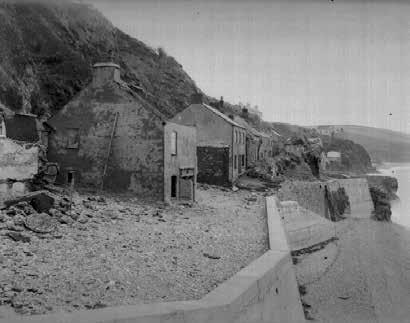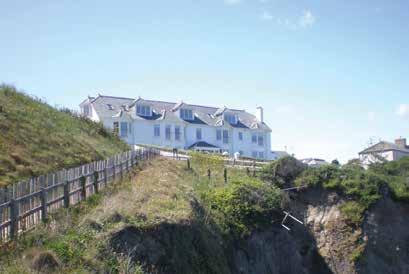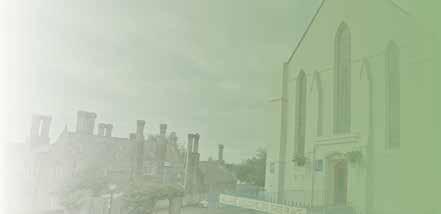
7 minute read
History
Hallsands: a predictable disaster
Hallsands was once a lively fishing village but now lies in ruins.
Advertisement
In the 1890s, Hallsands was a thriving village with 159 people living in 37 owner-occupied houses. The village was perched on the 25ft wave cut fossil platform backed by a cliff, protected from the sea by a wide expanse of shingle beach, where their fishing boats were beached. Tucked in to the east of Start Point, Hallsands was well protected from the prevailing southwesterly winds and storms. There was a grocer/baker, post office and pub – The London Inn. The main occupation was inshore fishing, but dairy products came from local farms, with the butcher visiting from Torcross. Even during storms like ‘The Great Blizzard of 1891’ the village suffered little damage, due to the protection of the shingle beach. All that changed in 1897, when Sir John Jackson was appointed to construct the new Devonport North Dock Yard. He decided to source the shingle needed to make the concrete from the Start Bay area, offshore between Hallsands and Beesands. Dredging commenced immediately, without prior consultation or warning. The first the villagers knew was when the dredger arrived offshore. They protested vehemently via the Devon Fisheries Committee and to local MP Frank Mildmay, concerned at the loss of their fishing grounds and the protective beach. Sadly, the shoreline landowner Mr Cole had agreed to it, and the area below high-water mark was controlled by the government. Eventually Sir John agreed to pay the village £125 a year for the loss of the fishing, with a further £200 at Christmas. Sir John reassured them the beach would replenish naturally in time. The villagers continued to press for the dredging to be stopped, so Sir John appointed Captain Vereker to investigate - a report was made to the Board of Trade which has, suspiciously, since been lost. In all 60,000 tons of shingle was removed. On New Year’s Day 1902, the frustrated fishermen surrounded the dredger - eight days later the licence was withdrawn and dredging ceased. However, it was too late to prevent disaster. Southeasterly storms in February 1903 and the winter of 1903/1904 washed over the village, destroying several houses and causing much damage. An area in front of The London Inn became a huge water-filled void. Luckily there were no fatalities but much work was needed to repair the houses and some villagers were left homeless. Besides Frank Mildmay and Mr H Ford of the Devon Fisheries committee, the villagers enlisted the help of Plymouth engineer and geologist Richard Hansford Worth to construct new sea walls. Hansford Worth made a detailed study of the whole area. By analysing the shingle from the beach, he demonstrated it would never replenish as it was a ‘fossil’ beach from interglacial periods. To demonstrate how great the loss was, he used before and after photographs. Eventually some compensation was paid by the government. The greatest help to the villagers was a fund set up by the Western Morning News. This enabled the building of four new homes on the cliffs near the coastguard cottages. For some years, life returned to pretty much normal for the villagers, although the beach was much lower and narrower than it had been before the dredging. On 26th January 1917 there was another violent southeasterly storm, which, although Hansford Worth’s wall held, overtopped the houses. With water pouring down their chimneys, and doors

and windows caving in, many thought they would die. Some managed to escape via the rear of their houses and scramble up the cliff to safety. This time, only the Prettijohn family house, highest up the path out of the village, remained intact. Again, amazingly, no one died, but most were homeless; and their way of life was destroyed along with their homes. Help continued to come from Frank Mildmay, Mr Ford of Devon Fisheries, R Hansford Worth, and the Western Morning News, who again set up an appeal for funds. The authorities dragged their feet over funding and building the promised Fordworth Cottages in North Hallsands. Eventually, they were ready for occupation in 1923 but were to remain in the ownership of the local council, so the villagers had to pay rent. This was not a good outcome, as the villagers had all owned their houses. In the six years they had waited, many lived in the ruined village or doubled up with friends and relatives. The three Trout sisters were more enterprising, and built a hotel on the cliffs, which opened to guests in 1925. The last of the sisters died in 1975, when it was sold and became holiday flats. Until their deaths in the 1960s the Prettijohn siblings lived in the last remaining house in the old village. It too became a holiday home. Since the loss of the village, the sea has continued to erode the coastline. Little shingle remains in the immediate vicinity of the old village, and at Greenstraight it continues to be eroded. The road at Greenstraight was also destroyed by storms in 2014. Without the protection of the beach the cliffs are rapidly eroding, with the area in front of the Trout Hotel badly affected. A large landslip in 2012 made the old viewing platform unsafe and undermined the outhouse of the old Prettijohn house. Years ago, the path to the old village was declared unsafe and the South West Coast Path route has been moved further inland. With coastal erosion it seems likely the cliff-top buildings will fall into the sea. This sorry tale of coastal mismanagement arose because, for economic reasons, Sir John Jackson used dredged shingle for the concrete rather than gravel from pits. Nowadays we are better informed and understand the impact of beach loss and climate change, but once again, Hallsands may be sacrificed for financial reasons if the money required to halt the erosion is not forthcoming.
Ursula Myers
Whoever you are, wherever you are on your journey, you are welcome here!

Visit tavistockurc.org.uk
for our latest news
Russell Street Tavistock PL19 8BD tavistockurc.org.uk 07982 622949
Minister: Revd Robert Weston tavistockurcminister@gmail.com
Tech tips from Chezvous PC
If you subscribe to Microsoft 365 – what used to be called Office 365 - and you have multiple users, you will have noticed that you see each other’s documents. This is not brilliant, particularly in an office environment. In order to change this, the owner of the subscription needs to ‘share’ Office with you rather than you ‘using’ one of their installations. From their Office account they ‘share’ with you to an email address. Once the email is received, the new user needs to have or create a Microsoft Account. That will then enable you to use what they share, in your own right, but keep other files separate from each other.
Winzip and WinRAR are programs that I regularly see on computers. They are 3rd party programs that do the job of software ALREADY on your computer to compress a folder and its contents for transmission usually by email. You may even end up paying for it after a while, unnecessarily. Folder compression was built into Windows a very long time ago – simply right click on the folder you want to compress and choose ‘send to’ then ‘compressed (zipped) folder’ and Windows will do it for you. When you receive a compressed folder just right click on it and choose ‘extract all’, then follow the wizard.
Wi-Fi printers are very useful, but really frustrating if you cannot get them to work as intended. The first issue is where it can go in the house. My rule of thumb is quite simple – same room, no problem; one room away and it will work well, but two rooms away is often asking too much of it, especially if you add in granite walls etc. Unfortunately, the transceivers in printers are never as good as they might be in our computers, so it does not always follow that ‘my computer works so why not my printer?’ You can always set it up in the same room as the router and then move it to where you would like it to be, then you will soon know whether it works. There are also repeaters and extenders you can employ to improve the Wi-Fi at distance if you really can’t change the printer location.
TIM Lambie Chez Vous PC
PC, Tablet & Mac Help
for home or business - visit or remote
Got a computer problem at home or o ice? The LOCAL help you have been looking for! Advice on PCs, laptops, tablets, printers, etc. New equipment setup – data transfer etc. Maintenance and help with Macs and iPads. Networking, cabling, broadband issues, email, etc. Solid State Drive upgrades Remote Access to system if preferred










